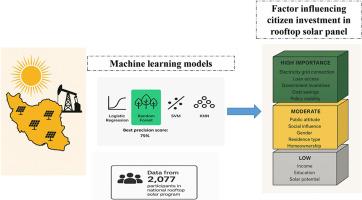公民投资屋顶太阳能板的预测因素:来自伊朗使用机器学习的社会创新项目的证据
IF 10
1区 环境科学与生态学
Q1 ENGINEERING, ENVIRONMENTAL
引用次数: 0
摘要
在大多数石油资源丰富的国家,尽管太阳能潜力很大,但这种能力没有得到充分利用,公民对太阳能项目的参与仍然有限。社会创新(SI),特别是在参与式融资领域,可以创造创新的、以社区为基础的模式,以调动可再生能源项目所需的财政资源,减少投资壁垒。因此,准确识别影响公民在该部门投资的因素对于设计有效的政策、金融工具和实施模式至关重要。我们研究了伊朗一个全国性的SI项目,并分析了来自2077名住宅屋顶太阳能系统安装参与者的数据。我们应用了四种机器学习算法——逻辑回归(LR)、随机森林(RF)、支持向量机(SVM)和k近邻(KNN)——来预测投资行为。RF模型达到了最高的测试准确度(77%),并揭示了与国家电网的连接、获得贷款、政府激励和对利益的理解是最重要的预测因素。公众对太阳能的态度、同伴压力、性别、居住类型和住房所有权状况也有显著影响,而家庭收入、教育程度和太阳能潜力的影响相对较小。研究结果表明,在石油资源丰富的经济体,消除金融障碍应辅以社会干预。从政策角度来看,这些结果强调需要根据人口和地区特点设计分段方案,利用现收现付融资、众筹模式、农村和服务欠缺地区示范项目等工具,并利用社交网络的影响力来提高参与度。通过将数据驱动分析与SI相结合,本研究为政策制定者和可再生能源利益相关者提供了一个实用框架,以加速和扩大向清洁能源的过渡。本文章由计算机程序翻译,如有差异,请以英文原文为准。

Predictive factors of citizen investment in rooftop solar panels: Evidence from a social innovation project in Iran using machine learning
In most oil-rich countries, despite their high solar potential, this capacity has been underutilized, and citizen participation in solar projects has remained limited. Social innovation (SI), particularly in the field of participatory financing, can create innovative, community-based models to mobilize the financial resources needed for renewable energy (RE) projects and reduce investment barriers. Therefore, accurately identifying the factors influencing citizens’ investment in this sector is essential for designing effective policies, financial instruments, and implementation models. We examined a national-scale SI program in Iran and analyzed data from 2077 participants in the installation of residential rooftop solar systems. We applied four machine learning algorithms—Logistic Regression (LR), Random Forest (RF), Support Vector Machine (SVM), and K-Nearest Neighbors (KNN)—to predict investment behavior. The RF model achieved the highest test accuracy (77 %) and revealed that connection to the national electricity grid, access to loans, government incentives, and understanding of benefits were the most important predictors. Public attitude towards solar energy, peer pressure, gender, type of residence, and homeownership status were also significant, whereas household income, education, and high solar potential had comparatively lower impact. The findings suggest that in oil-rich economies, removing financial barriers should be complemented by social interventions. From a policy perspective, these results underscore the need to design segmented programs based on demographic and locational characteristics, utilizing tools such as PAYG financing, crowdfunding models, demonstration projects in rural and underserved areas, and leveraging the influence of social networks to enhance participation. By linking data-driven analysis with SI, this study provides a practical framework for policymakers and RE stakeholders to accelerate and broaden the transition to clean energy.
求助全文
通过发布文献求助,成功后即可免费获取论文全文。
去求助
来源期刊

Journal of Cleaner Production
环境科学-工程:环境
CiteScore
20.40
自引率
9.00%
发文量
4720
审稿时长
111 days
期刊介绍:
The Journal of Cleaner Production is an international, transdisciplinary journal that addresses and discusses theoretical and practical Cleaner Production, Environmental, and Sustainability issues. It aims to help societies become more sustainable by focusing on the concept of 'Cleaner Production', which aims at preventing waste production and increasing efficiencies in energy, water, resources, and human capital use. The journal serves as a platform for corporations, governments, education institutions, regions, and societies to engage in discussions and research related to Cleaner Production, environmental, and sustainability practices.
 求助内容:
求助内容: 应助结果提醒方式:
应助结果提醒方式:


